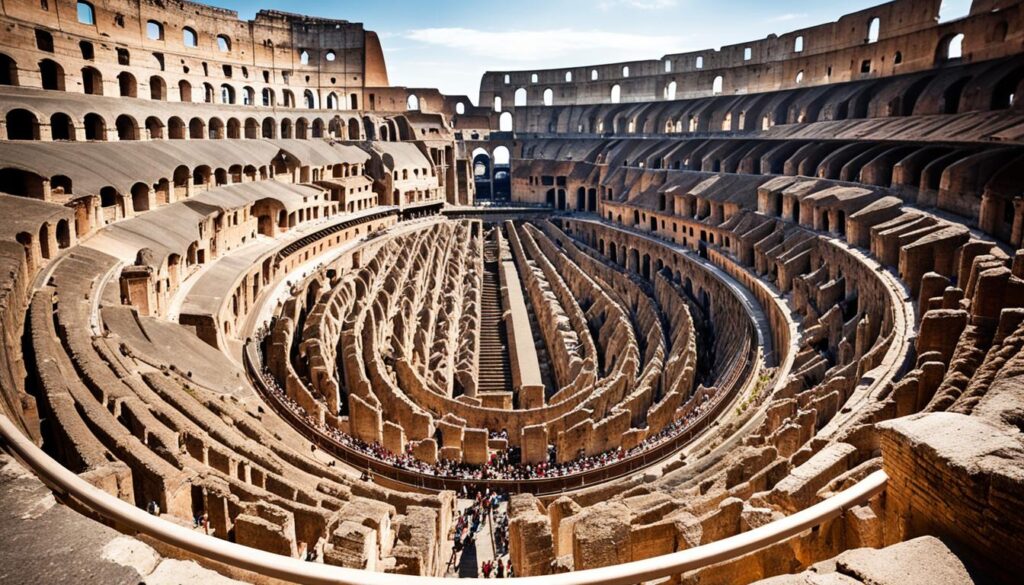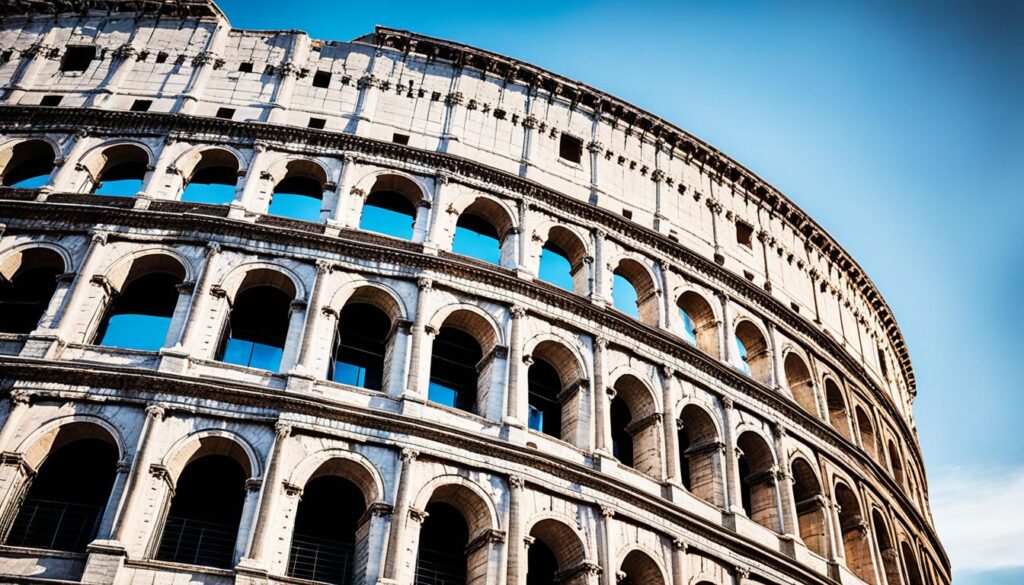The Colosseum is a true marvel of ancient Roman engineering and architecture. It’s one of the most iconic structures in the world. Built in the 1st century AD, it has seen the grandeur of the Roman Empire.
It’s in the heart of Rome, showing the ingenuity and cultural importance of ancient Rome. From its start as a place for gladiator fights to being a UNESCO World Heritage Site, the Colosseum has stood the test of time.
Learning about the Colosseum’s history is fascinating. It tells of Roman engineering, public entertainment, and the lasting impact of ancient Rome. This iconic building inspires people worldwide, showing us ancient Roman history and culture.
An Introduction to the Iconic Cultural Wonder
The Colosseum is a massive and awe-inspiring structure. It shows the skill and engineering of ancient Rome. Built from 70 to 80 AD, it’s a cultural wonder that draws visitors from all over.
The Colosseum: A Testament to Ancient Roman Ingenuity
The Colosseum’s size and complexity show the skill of Roman engineers and architects. It could hold up to 80,000 spectators, making it one of the biggest amphitheaters. The use of concrete and advanced systems helped make it stable and functional.
The Colosseum was a center for public events in ancient Rome. It hosted gladiator fights, animal hunts, and plays based on myths. These events drew huge crowds, showing the Colosseum’s importance and appeal.
The Colosseum’s Awe-Inspiring Architecture
The Colosseum is a key landmark in Rome’s heart. It shows the skill and architectural genius of ancient Rome. Made with stone, concrete, and brick, it highlights the Romans’ skill in building and their aim for grandeur.
The Colosseum’s design is a wonder of engineering. Its outside has arched entrances, columns, and detailed decorations. Inside, it had tunnels and raised areas for events that thrilled people for years.
The Colosseum’s size, use of concrete and stone, and advanced building methods show Roman skill. It could hold thousands and host various events, proving the Romans’ creativity and practicality.
The Colosseum’s stunning architecture is a lasting tribute to ancient Roman building skills. It shows their dedication to making structures that would amaze and inspire people for ages.
Gladiatorial Games: Spectacles of Bravery and Brutality
The Colosseum’s most famous events were the gladiatorial games. These games were a key part of ancient Roman entertainment and culture. Skilled fighters, often prisoners or slaves, battled each other or wild animals in a fight to the death.
The games drew huge crowds. People were amazed by the bravery, skill, and sometimes mercy shown by the fighters.
The Thrill of Ancient Roman Entertainment
The gladiatorial games were a big deal in ancient Rome. People looked forward to these violent events. They gave a peek into the harsh reality of Roman society.
The Colosseum was the perfect place for these events. Its grand design and large seating could hold crowds from all backgrounds.
These games were more than just a show of strength. They were a way for the Roman elite to show their power. They also showed how much people loved the excitement and danger of these events.
Today, we might see the gladiatorial games as brutal. But back then, they were a big part of Roman life and fun. The Colosseum’s design made it the ideal place for these events. For centuries, they kept the Roman public entertained.
The Colosseum’s Role in Ancient Roman Society
The Colosseum was more than just a place for fun in ancient Rome. It showed the Roman Empire’s strength and status. The government paid for its building and upkeep. The big shows there helped the rulers win the people’s hearts and keep their power.
A Symbol of Power and Prestige
The Colosseum brought people from all walks of life together. Everyone, from the rich in their special box to the common folk standing, saw the amazing events. It showed the social order of ancient Rome.
But the Colosseum was more than a place for fun. It showed off the Romans’ skill in building and technology. Its huge size and beauty showed the Roman Empire’s big dreams and desire to lead.

The Colosseum was very important in ancient Roman life. It was a key tool for the rulers to keep control and stay on top. Today, it still amazes people all over the world with its cultural and architectural impact.
Preserving the Colosseum’s Legacy
The Colosseum, a symbol of Rome, has seen many challenges over the years. Earthquakes, fires, and neglect have threatened it. Yet, thanks to preservationists, it still stands as a sign of ancient Roman skill.
Now, the Colosseum is a UNESCO World Heritage Site. This status highlights its cultural importance and the need for its preservation. Visitors from all over come to see its beauty and learn about its history. This tourism helps fund efforts to keep the Colosseum safe for the future.
Work is being done to keep the Colosseum stable and its details restored. These efforts are key to keeping the site safe and sharing its history with others. They help make sure the Colosseum’s cultural heritage is preserved for generations to come.
Cultural Wonders: The Colosseum’s Enduring Significance
The Colosseum once stood tall in ancient Rome, now it’s a symbol of culture and history. It shows the Roman Empire’s creativity and skill. People from everywhere are drawn to its beauty and history.
It’s more than just a place for old-time shows. The Colosseum is a cultural wonder that still moves and stuns us today.
A Timeless Monument to Human Achievement
The Colosseum is not just an old relic. It shows how humans can achieve great things in engineering, architecture, and culture. Its size, design, and the tech used to build it show the Romans’ skill.
It’s a symbol of what humans can do. The Colosseum reminds us of the amazing things our ancestors achieved.
The Colosseum’s impact goes beyond its design. It’s a symbol known around the world, bringing awe and wonder to all who see it. Its fame and status as a UNESCO World Heritage Site prove its lasting value.
It’s a cultural treasure, a nod to ancient Rome, and a true wonder of the world.
Exploring the Colosseum’s Intricate Construction
The Colosseum is a symbol of ancient Rome’s engineering skill. It was built with a mix of materials and new building methods. This made it a huge achievement.
The base of the Colosseum was made from stone, concrete, and brick. The outside walls were mainly travertine, a kind of limestone. This strong base was needed to hold up the huge building. It was 157 feet tall and could hold up to 80,000 people.
Underneath the Colosseum, there was a complex system of tunnels and rooms called the hypogeum. This network helped with the events like animal hunts, executions, and gladiator fights. It made everything run smoothly.
The Colosseum shows off Roman engineering at its best. It was built with smart techniques and materials. Today, archaeologists and historians are still learning about how it was made. They find new things that show the skill of the ancient Romans.
The Colosseum’s Influence on Modern Architecture
The Colosseum’s design has reached far beyond ancient Rome. Its unique features like arched entrances and tiered seating have influenced many buildings. Today, you can see its impact in sports stadiums, theaters, and concert halls around the world.
This makes the Colosseum a true architectural masterpiece. It shows the lasting effect of Roman architecture on modern design.
Echoes of Ancient Roman Design
Architects and designers have looked to the Colosseum for inspiration for centuries. Its use of arches, domes, and strong walls is key to its Roman style. These elements are now seen in many modern buildings, linking the old to the new.
The Colosseum’s mix of beauty and practicality has inspired many. Architects aim to create buildings that look good and work well, just like the Colosseum.
Its influence is clear in big stadiums and theaters worldwide. The Colosseum reminds us of ancient Roman ingenuity. It shows how their designs still shape our buildings today.

Visiting the Colosseum: A Journey Through Time
Visiting the Colosseum in Rome is an amazing experience. It lets you step back in time and dive into ancient Rome’s rich history. This iconic site is one of the top places to visit in the world, showing the grandeur of the Roman Empire.
When you go to the Colosseum, you’ll be amazed by its size and design. The huge amphitheater was once the place for thrilling gladiator games. Walking inside, you can feel the excitement of the past, when people eagerly watched these events.
It’s not just about seeing its beauty; it’s also a chance to learn about its history and importance. The Colosseum shows the power and creativity of the Roman civilization. By checking out the exhibits and educational stuff, you can learn more about its role in ancient Rome and the events it hosted.
If you love history, architecture, or just want to see ancient Rome’s grandeur, the Colosseum is a must-see. Its design, history, and lasting impact make it a favorite among visitors worldwide. They come to see this ancient wonder and be inspired by its beauty.
The Colosseum’s Place in Roman Mythology and Legend
The Colosseum in Rome is more than just a building. It’s a key part of ancient Roman mythology and legend. Stories of brave gladiators, royal secrets, and supernatural events have thrilled people for centuries. These stories make the Colosseum a symbol of mystery and importance.
Roman legends made the Colosseum a place of the extraordinary. They told stories of gladiators who beat the odds and won against fierce beasts. These stories inspired awe and respect for the Colosseum’s thrilling shows of courage and strength.
The Colosseum is also linked to the supernatural. People talk about haunted halls, ghostly figures, and strange happenings inside the big theater. These stories make the Colosseum seem like a place where the ordinary and the magical meet.
The Colosseum’s role in Roman myths and legends has made it a symbol of the world’s most famous and meaningful sites. These stories still amaze and inspire us, proving the Colosseum’s lasting impact. It shows the creativity and spirit of ancient Roman culture.
The Colosseum as a Backdrop for Iconic Cultural Events
The Colosseum in Rome has been a key place for history. It has hosted many cultural events that have made a big impact. From ancient Roman shows to today’s concerts, it’s seen it all.
A Stage for History
Back in the Roman Empire, the Colosseum was where gladiators fought and people watched. It was also where public executions and big shows took place. These events showed the power and values of the Roman Empire.
Today, the Colosseum is still a popular spot for cultural events. You can find everything from classical music to theater here. Its history makes it a unique place for events.
Recently, the Colosseum has been the spot for political rallies and religious events. It shows how important the Colosseum is in history. It’s a symbol of human achievement and a place for cultural expression.
The Colosseum is still a big deal today. It hosts top-notch shows and is a place for artists to express themselves. Its history makes it one of the world’s most famous cultural spots.
The Enduring Legacy of the Colosseum
The Colosseum is a symbol of ancient Roman greatness and a cultural icon. Its design and history amaze people worldwide. Thanks to preservation efforts and its UNESCO World Heritage status, it will keep inspiring us for years.
Visitors from all over come to see the Colosseum’s beauty and learn about its past. This shows how much it means to us today. It connects us to the creativity and innovation of ancient Rome.
Keeping the Colosseum safe is now more important than ever. Preservation groups and international support help protect it. This ensures the Colosseum remains a symbol of human greatness for the future.






